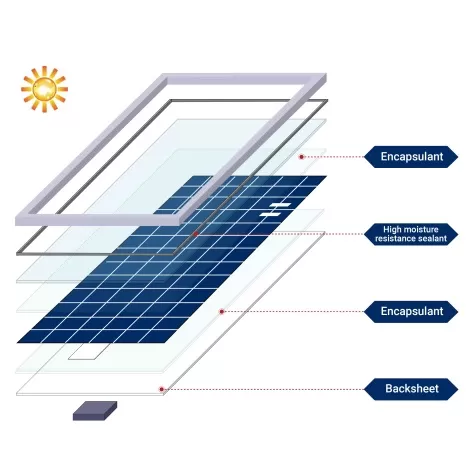The Rise of Heterojunction Solar Cells: Unlocking Potential with Optical Conversion Films
The solar energy industry is undergoing a significant transformation, with heterojunction solar cells (HJT) poised to enter a phase of large-scale development. Since 2022, the manufacturing costs associated with HJT cells and modules have consistently decreased, leading to an accelerating trend toward mass production. This blog delves into the key advancements, challenges, and opportunities associated with HJT technology and optical conversion films, which play a crucial role in enhancing the performance of these high-efficiency photovoltaic devices.

Understanding Heterojunction Solar Cells
Heterojunction solar cells, or HIT cells, are a type of high-efficiency crystalline silicon solar cell characterized by their unique structure. They are known for their flexible design, long lifespan, and ability to generate power from both sides. Compared to passivated emitter and rear cell (PERC) technology, HJT cells exhibit a more sensitive transparent conductive oxide (TCO) layer, particularly in environments exposed to ultraviolet (UV) light, acids, and humid conditions. Prolonged exposure to UV light can degrade the Si-H bonds on the cell surface, negatively impacting efficiency and longevity.
To mitigate these challenges, manufacturers typically utilize UV-blocking encapsulation solutions. However, traditional methods may hinder the ability of HJT cells to harness short-wavelength light, which diminishes their competitive edge. Optical conversion films, designed specifically for HJT applications, offer a promising solution by converting UV light into visible blue light, thereby reducing cell degradation while enhancing overall module power and stability.
The Role of Optical Conversion Films
Optical conversion films, also known as light conversion films for heterojunction cells, are innovative materials developed to optimize the performance of HJT technology. These films are created by adding optical conversion agents to high-transmission films, allowing for the transformation of UV light into blue light, thereby improving the efficiency of solar modules.
Recent testing has indicated that using optical conversion films can boost module efficiency by approximately 1.5% compared to traditional UV-cut encapsulation solutions. Additionally, these films are designed to maintain high reliability for over 50 years, making them a durable choice for solar manufacturers.
Key Features of Optical Conversion Films
Optical conversion films possess several remarkable characteristics that enhance their usability:
Co-extruded PO Material: High conversion efficiency with excellent UV resistance.
Storage Conditions and Shelf Life: To ensure optimal performance, films should be stored away from direct sunlight, in environments maintaining a temperature of 25±15°C and humidity levels of 55±15%. The shelf life is three months from the production date, and it is recommended to use the opened product within six hours.
Performance Characteristics
Here’s a detailed overview of the performance characteristics of optical conversion films:
| Property | Unit | Typical Value | Standard |
|---|---|---|---|
| Thickness | μm | Standard±10% | GB/T 6672-2001 |
| Weight | g/m2 | ≥ Standard | Saiwu Method |
| Width | mm | 200-2200 | - |
| Surface Structure | - | Embossed | - |
| Density | g/cm3 | 0.85-0.95 | ISO 1183 |
| Tensile Strength | MPa | MD≥6.0, TD≥5.0 | ASTM D-882 |
| Elongation at Break | % | MD≥400, TD≥40 | - |
| Peel Strength with HJT | N/cm | ≥25 | Saiwu Method |
| Peel Strength with Glass | N/cm | ≥60 | GB/T 29848-2018 |
| Peel Strength with Backsheet | N/cm | ≥40 | - |
| Thermal Shrinkage | % | MD≤3.0, TD≤1.5 | - |
| Crosslinking Degree | % | 75≤X≤95 | - |
| Transparency (280-380nm) | % | ≤20 | - |
| Transparency (380-1100nm) | % | ≥90 | - |
| Volume Resistivity | Ω*cm | ≥1×1015 | - |
| Yellowing Index after 1000h DH | / | △YI≤5 | - |
| Peel Strength with Glass after 1000h DH | N/cm | ≥40 | - |
| Yellowing Index after 120kWh UV | / | △YI≤5 | - |
| Water Vapor Transmission Rate | g/m2*day | ≤5.0 | 38℃、90%RH、500um |
The Transition from P-Type to N-Type Technologies
As the photovoltaic industry evolves, the shift from P-type to N-type technologies is becoming increasingly apparent. Factors influencing the industrialization of N-type technologies, particularly HJT and TOPCon, include the speed of equipment delivery and the varying capabilities of manufacturers in terms of production line construction and commissioning.
For HJT technology, a significant breakthrough is the development of skilled personnel. The workforce required for HJT is distinct from that of traditional crystalline silicon systems, leading to a talent shortage across battery manufacturers, equipment suppliers, and material providers.
Challenges Facing the Development of HJT Technology
Despite the promising outlook for HJT, challenges remain. The number of companies actively pursuing HJT technology is limited, creating a perception that cost reduction and efficiency improvements are slow processes. New technology adoption requires a period of adaptation for clients, with many still uncertain about the reliability of HJT components.
However, as more clients recognize the advantages of HJT technology, such as increased power generation, the market is beginning to respond positively. A recent example includes a tender by Guodian Investment for a 160 MW order that specifically called for HJT components.
Driving Efficiency and Cost Reduction in HJT Technology
To enhance efficiency and reduce costs in HJT technology, several key areas are being explored:
Product Structure: Optimizing the design of solar cells for improved performance.
Material Selection: Focusing on silicon wafer quality, optimizing ITO film performance, and refining metal electrode materials.
Production Process Control: Tightening controls on nanometer-scale layers to directly influence efficiency.
Silicon Wafer Thickness Reduction: Transitioning from 130 microns to 120 microns, with a final goal of reaching 90 microns.
Future Outlook for HJT Technology
This year, it is estimated that HJT shipments will reach around 10 GW, with projections for next year indicating growth to 40-50 GW. The rapid advancement in HJT technology presents a promising opportunity for widespread adoption in the solar energy sector.
Challenges of HJT Mass Production
Despite the advantages of HJT technology, its cost remains higher than that of PERC and TOPCon systems, posing a significant challenge for mass production. Collaborations among HJT partners are focused on reducing costs and improving efficiency through strategies such as minimizing the use of silver paste, reducing target material requirements, and optimizing wafer thickness.
Enhancing HJT Efficiency
Key areas of focus for improving HJT efficiency include:
Microcrystalline Technology: Enhancing fill factor, conductivity, and light transmission to achieve efficiency gains.
Metalization Techniques: Implementing copper plating and zero-busbar technology to decrease silver paste consumption while increasing grid line efficiency.
Optical Conversion Films: Utilizing these films to boost HJT performance by converting UV light into usable energy.
Conclusion
The development of heterojunction solar cells represents a significant advancement in photovoltaic technology, with the potential for improved efficiency and reduced costs. Optical conversion films are integral to realizing this potential, offering innovative solutions that enhance HJT performance while addressing the challenges posed by UV exposure. As the industry continues to evolve, the prospect of HJT becoming a mainstream technology is increasingly likely, paving the way for a more sustainable and efficient solar energy future.
For more insights into solar manufacturing technologies, you can explore our company, Ooitech, which offers 15 years of experience in the solar industry, providing equipment for solar panel production lines and comprehensive training services. To learn more, visit our YouTube channel and check out our MBB Full Automatic Solar Panel Production Line Video. Additionally, you can download our catalog and company profile for more information.
